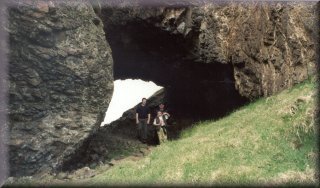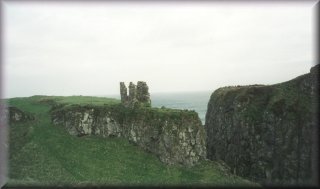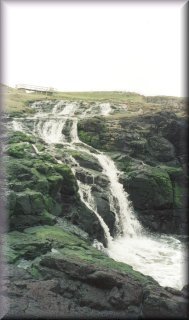Dunseverick
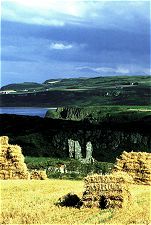
|
Dunseverick
Harbour
|

|
|
Portbraddon
|
|
Holiday
Accommodation
|
|
North Antrim Map |
|
North Antrim
Main Menu |
|
North Antrim Locations |
|
Dunseverick Castle
|
North Antrim Gift Shop
|
Portmoon
|
|
Part of a
tower is all that remains of Dunseverick Castle which was destroyed by
a Scottish army sent here in 1642 under the command of
General Munro
to combat the rebellion by Rory O'More, Lord Maquire and Sir Pheilim O'
Neill which started in 1641. The ruin you see today dates to the mid
1500's and was probably built by the
MacDonnell clan
who had establish a power base along the north coast. Surrounded by the
ocean on three sides, Dunseverick was a key ancient site in Ireland,
one of the royal roads from Tara, seat of the
Kings of Ireland ended here.
It was originally founded by Sobairce, one of the Kings of Ireland who built a fortress
here in 1525BC to rule the ancient Kingdom of Dariada, the location is named
after him - Dunsobairce (Fortress of Sobairce) now Dunseverick. Many heroes of Irish legends such as
Cuchulain,
Queen Maeve and Turlough are associated with the area. Another fact for
anyone walking up to the castle and taking in the breathtaking view to
Portmoon - if you do, then you can rest safe in the knowledge that you
have walked in the footsteps of Saint Patrick. It is known he visited
Dunseverick on several occasions and on one of these occasions he
baptized a local man called Olcan, who became Bishop of Armoy and
later a Bishop of Ireland, Olcan died in 480AD. A well which existed a
few feet from the cliff edge is named after St. Patrick and reputed
to be be one of the 'holy' wells of Ireland, though sadly, the
christening stone and the seat he used still lie unfound in the waters
below, having been tumbled there during a time of upheaval.
|
http://www.northantrim.com/dunseverick.htm
|
6.-- DALRIADA,* OR PART OF ANTRIM AND DERRY
THE IRISH CHIEFS AND CLANS
THE chiefs and clans in Dalriada were as follows:--The O'Cahans,
and MacQuillan, who held the territory of the Routes , and had their chief
seat at Dunluce. The MacDonnells of the Hebrides invaded, A.D. 1211, the
territories of Antrim and Derry, where they afterwards made settlements.
|
|
In the reign of Elizabeth, Somhairle Buidhe MacDonnell or "Sorley Boy,"
as he was called by English writers,-- a chief from the Hebrides, descended
from the ancient Irish of the race of Clan Colla, came with his forces
and took possession of the Glynns.
http://www.angelfire.com/my/tray/Page-4.htm
|
Sobairce
From Wikipedia,
Sobairce, son of Ebric and a great great grandson of Míl Espáine, was, according to medieval Irish legend and historical tradition, joint High King of Ireland with his brother Cermna Finn.[1] The pair came to power after Cermna killed the previous incumbent, Eochaid Étgudach, in battle at Tara. They were the first High Kings to come from the Ulaid. They divided the country between them, the border running from Drogheda to Limerick.[2] Sobairce ruled the northern half from Dún Sobairce (Dunseverick in County Antrim), Cermna the southern half from Dún Cermna (which Keating identifies as Downmacpatrick in Kinsale, County Cork). They ruled for forty years.
|
Stones of Giants
A stone's throw from Dunseverick Castle, capital of the ancient kingdom of Dalriada, 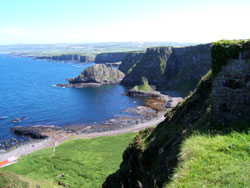 and
nestled amongst the majestic basalt cliffs of the Giants Causeway lies
the Port Moon Fishery. For hundreds if not thousands of years the men
of the Causeway Coast have used Port Moon Bay to harvest the Atlantic
Ocean ~~~~ and
nestled amongst the majestic basalt cliffs of the Giants Causeway lies
the Port Moon Fishery. For hundreds if not thousands of years the men
of the Causeway Coast have used Port Moon Bay to harvest the Atlantic
Ocean ~~~~
http://schwang.co.uk/portmoon/index.htm 
|
Annals of Ulster

|
|

|
|
Dunseverick Dunseverick (Dún Sebuirge)
From Wikipedia,
Dunseverick is a hamlet located near the Giant's Causeway in County Antrim, Northern Ireland.
|
Dunseverick Castle and the peninsula on which it stands were given to the National Trust in 1962 by local farmer Jack McCurdy. The Causeway Cliff Path also runs past on its way to Dunseverick Harbour to the east and to the Giant's Causeway to the west.
The castle was occupied until its capture and destruction by Cromwellian troops in the 1650s, and today only the ruins of the gatelodge remain. A small residential tower survived until 1978 when it eventually surrendered to the sea below.
|
|

|

It was a 'key' ancient site in Ireland. One of the royal roads from Tara, seat of the Kings of Ireland ended at Dunseverick castle. This ancient road was known as Slige Midluachra or High Kings Road.
The castle had a well that existed on the north side, about three
yards from the edge of the cliff, which is over one hundred feet above
the sea. The well was called Tubber Phadrick, or St. Patrick's Well. It
is reputed to be one of the 'holy' wells of Ireland. St. Patrick,
apparently, visited Dunseverick on several occasions on his travels
through the North.
http://www.northantrim.com/dunseverick.htm
|
|

|
|










